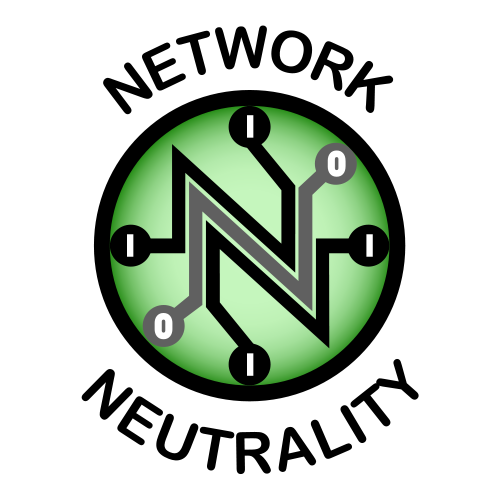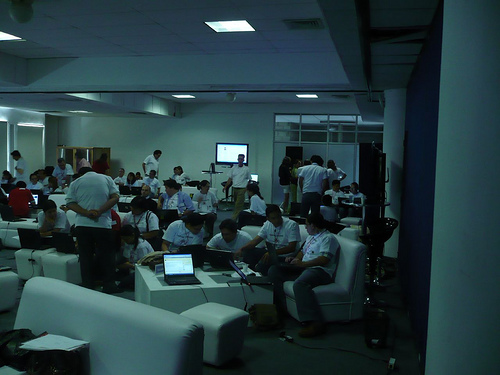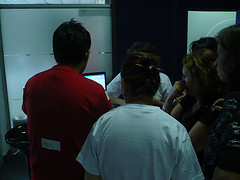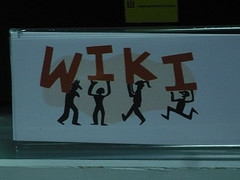(This is a long post, born out of years of frustration with ineffective institutional collaborations. If you only want the highlights, here they are: grow your network by sharing, not planning to share or deciding who to share with; the tech doesn’t determine the sharing – if you want to share, you will; weave your network by sharing what you can, and they will share what they can – people won’t share [without a lot of added incentives] stuff that’s not easy or compelling for them to share. Create virtuous cycles that amplify network effects. Given the right ‘set,’ simple tech is all they need to get started.)
I have been asked to participate in many projects over the years that start once a bunch of departments, institutions or organizations notice that they have a lot in common with others and decide that it would be a good idea to collaborate, to share “best practices” or “data” or whatever. It always ‘sounds’ like a good idea. I am big on sharing and have benefited much over the years from stuff I’ve shared and stuff shared with me by my peers.
But inevitably, with a very few exceptions, these projects spend an enormous amount of time defining what is to be shared, figuring out how to share it, setting up the mechanisms to share it, and then…not really sharing much. Or sharing once but costing so much time, effort or money that they do not get sustained. Does this sound familiar to anyone else? I don’t feel like this phenomenon is isolated to me or somehow occurs because of my own personal ineptitude, but you never know.
Now I contrast that with the learning networks which I inhabit, and in which every single day I share my learning and have knowledge and learning shared back with me. I know it works. I literally don’t think I could do my job any longer without it – the pace of change is too rapid, the number of developments I need to follow and master too great, and without my network I would drown. But I am not drowning, indeed I feel regularly that I am enjoying surfing these waves and glance over to see other surfers right there beside me, silly grins on all of our faces. So it feels to me like it’s working, like we ARE sharing, and thriving because of it.
So I began to wonder, why does one the (institutional-driven/focused) approach continually fail while my personal learning network continues to thrive. Here are some thoughts on why:
We grow our network by sharing, they start their network by setting up inital agreements
We just finished a workshop this week on “Weaving your own PLE.” While part of this was definitely an effort at straight tech training, that in my mind was actually the minor part – the whole reason many of us are so attracted to blogs, microblogs, social media, etc., in the first place is that they are SIMPLE to use and don’t require a lot of training.
No, in my mind, a lot of the message was helping newcomers to get over the hump of “well, I created a blog/joined this service/etc, but how come no one is reading it?” A lot of what we discussed were the practices by which you can grow your connections, and by and large these involve some form of sharing: writing interesting posts (sharing your insight and learning); writing comments (sharing feedback/conversation); publishing work in open spaces (and pointing to it). Your network will grow. It may take a little time, but it will grow. The other thing we emphasized was a line I think I stole from Dave Winer – “It doesn’t matter if there are only 2 people reading your blog as long as they are the right 2 people.” The notion that if you grow your network organically, don’t force it, it will settle, over time, on just what you need.
Contrast this with these formal initiatives to network “organizations.” In my experience, these start with meetings in which people first agree that sharing is a good idea, and then follow up meetings to decide what they might share, then, somewhere way down the line, some sharing might happen. The whole time, some of the parts of a network are already present and could have just started sharing what they have, heck they could have started before ever meeting, even WITHOUT ever meeting, but this never happens. (I say part, because if it’s a network it will grow to include many others not in any intial group.)
We share what we share, they want to share what they often don’t have (or even really want)
Much of the sharing that happens in my learning network happens through seredipity. People publish a blog post, bookmark a delicious link, etc, as a normal part of their own workflow,and whether through syndication or the “All seeing eye of Google,” it comes my way, as John Krutsch would say, “Right On Time.” Or I ask the network, through my blog or twitter, or sometimes directly, for help with a question or problem: sometimes the answer comes in seconds, because someone’s already worked it out; sometimes in minutes, maybe because a slight twist needs to be given to existing work; sometimes in days or weeks, when it tweaks someone else’s mind as much as mine and they do the work because it seems worhtwhile to them and they can do it; sometimes it comes in months or years, because it’s a big problem. But so far, it’s never not come, eventually. Our sharing is “good enough,” not perfect; optimal, not ideal. We don’t build our entire houses on this single foundation, but it sure helps get a lot of structure built quickly on many an occassion.
Contrast this with the formal approach. In my experience, a ton of time goes into defining ahead of time what is to be shared. Often with little thought to whether it’s actually something that is easy for them to share. And always, because its done ahead of time, with the assumption that it will be value, not because someone is asking for it, right then, with a burning need. Maybe I’m being too harsh, but my experience over a decade consulting and working on these kinds of projects is that I’m not. Someone always thinks that defining these terms ahead of time is a good idea. And my experience is that you then get people not sharing very much, because to do so takes extra effort, and that what does get shared doesn’t actually get used, because despite what they said while they were sitting in the requirements gathering sessions, they didn’t actually know what the compelling need was, it just sounded like a good idea at the time.
By the way, if my writing is making it seem that I haven’t done this myself, many times, that’s just wrong. For the longest time, it seemed like a good idea to me too.
We share with people, they share with “Institutions”
I have never spoken to “an institution.” I would be scared if one started to speak to me. But I’ve spoken and shared with many *people* in institutions. Many *people* use stuff I have shared. And usually, in my experience, its people who directly, not through some intermediary, have a need.
The institutional approach, in my experience, is driven by people who will end up not being the ones doing the actual sharing nor producing what is to be shared. They might have the need, but they are acting on behalf of some larger entity. The need ends up getting diffused over all the people involved ultimately in sharing, and the people who go to the meetings, form the relationships, have *the actual network* end up delegating the work to people who are excluded from the network, acting as proxies, instead of forming their *own* network. There is nothing stopping them from doing so except the need being defined at the top of the org but driven to the bottom, instead of the need being defined (differently) at each level of the organization and at each level personal networks being built (and if this were happening, the whole notion of “levels” would no doubt start to get a bit woobly.)
We develop multiple (informal) channels while they focus on a single official mechanism
I blog. I use twitter. I use delicious. I use flickr. I use facebook (when I have to.) I use drop.io. I use slideshare. I use scribd. I use google docs. I use… the list goes on and on. Many of the ones above are ones that have persisted in my practice for some time now, while there are others that come and go. The point is, though, I have yet to come across a situation where someone in my network asked for help (through any of these channels, or indeed simply through email) and I (or someone in the network) did not find SOME way to share what they needed with them. More often than not, we’d shared it ahead of time and it’s Google finding it, and typically always things are shared in a way that allowed everyone else simply to benefit from that act of sharing. The technology is NOT the problem. Given a compelling need to connect, people will find a way, be it through smoke signals, Morse code or Usenet news groups.
Contrast this with these formal initiatives to network “organizations” – in my experience, much time goes into finding the right single “platform” to collaborate in (and somehow it always ends up to blame – too clunky, too this, too that.) And because typically the needs for the platform have been defined by the collective’s/collaboration’s needs, and not each of the individual users/institutions, what results is a central “bucket” that people are reluctant to contribute to, that is secondary to their ‘normal’ workflow, and that results in at least some of the motivation (of getting some credit, because even those of us who give things away still like to enjoy some recognition) being diminshed. And again, in my experience, in not a whole lot of sharing going on.
What to do if you are stuck having to facilitate sharing amongst a large group of institutions?
So hopefully it’s clear at this point that I am a big believer in everyone, no matter what their role in an organization, developing their own personal learning network/environment. But the reality is, you and I are going to get asked for years to come to help groups who say they want to share. So what do we do. Well, if you can, my advice is to provision as little tech as possible and urge an approach that focuses on the sharing and the network creation first. But if you must provide a single “platform,” my advice is to focus on providing one with these three simple pieces:
- a simple way to find out who else is out there (profile, even just a directory)
- some simple channels to communicate: email lists/addresses, threaded discussions
- a simple way to publish content
That’s it. Maybe a synchronous tool. If the need and desire to share is real, these basic means (which really, they already have access to, but sometimes you need to build them a new one, after all we all like to feel special sometimes) are ALL THEY NEED TO SHARE. You see, at the end of the day, that’s all any of us, who started building our personal learning networks with, say, blogs, actually had. And it worked. It works every day. – SWL
 The other new stuff, which is more important, but MUCH more raw, has been prompted by concerns that have been niggling me for years. I am not sure if these are “essential” effects of using the net, but I have experienced, and others have noted, that the net can lead us to pay possibly too much attention to the immediate, and not enough reflecting on what has happened or where we want to go. I take the emergence of the GTD movement to be very much an early reaction to this by people deeply immersed in learning/working with technology. I also worry about the phenomenon of the “echo chamber,” that diversity in our networks doesn’t just magically “happen.”
The other new stuff, which is more important, but MUCH more raw, has been prompted by concerns that have been niggling me for years. I am not sure if these are “essential” effects of using the net, but I have experienced, and others have noted, that the net can lead us to pay possibly too much attention to the immediate, and not enough reflecting on what has happened or where we want to go. I take the emergence of the GTD movement to be very much an early reaction to this by people deeply immersed in learning/working with technology. I also worry about the phenomenon of the “echo chamber,” that diversity in our networks doesn’t just magically “happen.” So, “examining where we’ve already been” might take the form of a plug-in like Wikipedia Diver that records and visualizes your wikipedia sessions, to simple suggestions like one Mike Caulfield made a few weeks back to make reviewing your browser history a regular activity. Using your blog as a constrained search engine, or even just searching your “outboard brain” are other examples of simple practices we can insert into our existing network flows that I think will increase reflection, help us learn what we know, know what we’ve learned.
So, “examining where we’ve already been” might take the form of a plug-in like Wikipedia Diver that records and visualizes your wikipedia sessions, to simple suggestions like one Mike Caulfield made a few weeks back to make reviewing your browser history a regular activity. Using your blog as a constrained search engine, or even just searching your “outboard brain” are other examples of simple practices we can insert into our existing network flows that I think will increase reflection, help us learn what we know, know what we’ve learned.

 And me? Well cowed as I was by these stellar co-speakers, I did my best not to throw up and
And me? Well cowed as I was by these stellar co-speakers, I did my best not to throw up and  You might have heard, but the CRTC (the regulatory body for all things broadcast and telephony here in Canada, very roughly equivalent to the FCC in the US) is holding hearings on claims that ISPs in Canada regularly ‘shape’ (a codeword for ‘limit’ or ‘slow down’) traffic on their networks, specifically P2P traffic. And as
You might have heard, but the CRTC (the regulatory body for all things broadcast and telephony here in Canada, very roughly equivalent to the FCC in the US) is holding hearings on claims that ISPs in Canada regularly ‘shape’ (a codeword for ‘limit’ or ‘slow down’) traffic on their networks, specifically P2P traffic. And as  But, in the spirit of a ‘camp,’ this was not a one-way exchange (hindered though I was by my absolute lack of Spanish, something I very much regret.) I truly learned much from the experience, both about the amazing country of Colombia, but also about how we should be running professional development workshops. The educamps were very inspiring. Every attention to detail had been paid to create the enabling conditions for learner-supported and learner-directed learning to occur.
But, in the spirit of a ‘camp,’ this was not a one-way exchange (hindered though I was by my absolute lack of Spanish, something I very much regret.) I truly learned much from the experience, both about the amazing country of Colombia, but also about how we should be running professional development workshops. The educamps were very inspiring. Every attention to detail had been paid to create the enabling conditions for learner-supported and learner-directed learning to occur.
 ools (they did not focus on single specific tools but instead general classes, like ‘Readers’ or ‘social bookmarking tools’) with which they had experience. In doing this, partly they were making a promise to other learners that if someone came up and asked them about one of their tags, they would talk to them about it.
ools (they did not focus on single specific tools but instead general classes, like ‘Readers’ or ‘social bookmarking tools’) with which they had experience. In doing this, partly they were making a promise to other learners that if someone came up and asked them about one of their tags, they would talk to them about it.